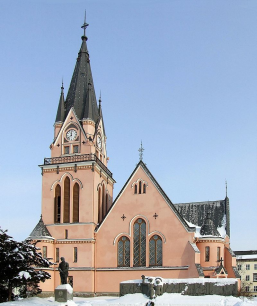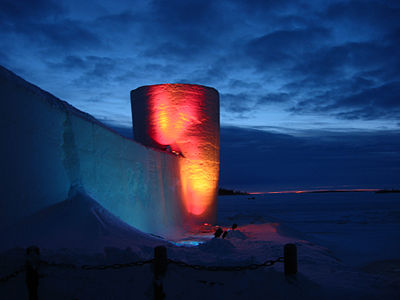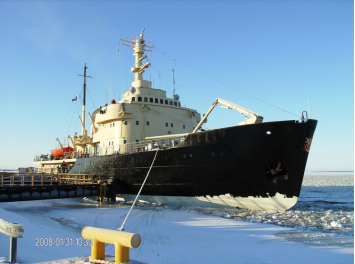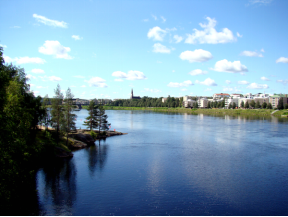Kemi, Lapland 作者: 来源: 发布时间:2021-03-31
一、人口,面积
Kemi (Northern Sami: Giepma; Swedish (historically):Kiemi) is a town and municipality of Finland. It is located very near the city of Tornio and the Swedish border. It was founded in 1869 by a decree of the Russian Emperor Alexander II because of its proximity to a deepwater port.

二、自然地理
地理条件
Kemi is situated on the Bothnian Bay, at the mouth of the river Kemijoki, and it is part of the Lapland region. The town has a population of 20,991 (31 January 2019) and covers an area of 747.28 km2 (288.53 sq mi) of which 652.1 square kilometers (251.8 sq mi) are water. The population density is 220.17 inhabitants per square kilometre (570.2/sq mi).

三、经济发展和规模
The main economic activity in Kemi is centered on two large paper and woodpulp mills and on the only chromium mine in Europe (which supplies the Outokumpu ferrochrome plant in Tornio).
The Chinese company Kaidi has announced plans to build the world's first second-generation biomass plant in Kemi, scheduled to begin operations in 2019.
In April 2007, the city of Kemi laid off all of its municipal workers for 2 weeks due to the failing economy of the city. Spiraling specialist healthcare costs and a fleeing industry tax base are stated as the cause for the firing. These are the most drastic temporary dismissals to take place in Finland since 2000.
As mentioned earlier, the city is located on the Kemi-Tornio Axis, a subregion of the economic and industrial center of Lapland; Kemi is the most populous municipality and the one with the most industrial weight, it is the city that pulls the Axis. The districts of Ajos and Karihaara are, in fact, the most industrialized areas, where Metsä-Botnia and Stora Enso are the main factories of the paper and pulp mill and the port of Kemi. It is also worth mentioning that Kemi-Tornio is the sub-region with the highest GDP per capita in Lapland; Fifth in Finland after Mariehamn, Helsinki, Salo and Loviisa. Among others, the headquarters of Lounais-Lappi and Pohjolan Sanomat, the most widely read newspapers in the Maritime Lapland, are also located in Kemin.
The chemical port has always been of paramount importance. XIX. Before the 16th century, it was the main feature of the fishing village, and when the city was created and the port was enlarged in 1869, it became an essential infrastructure for the economy. Thanks to the port, Kemi replaced Tornio, who was going down the abyss, and became the leader of Lapland. In these early years, the Kemi-Tornio Airport, Laurila-Kelloselkä, which would join Eastern Lapland and Rovaniemi, and the Tornio-Oulu Railway, which would join Oulu, were also built. Thus, thanks to these infrastructures, the city became the gateway to Lappi province. Kemi Oy and Veitsiluoto Oy, also companies in the paper industry, were founded at the same time. It was the great economic revolution known as the golden age of the twentieth century. II. Although World War II halted production, as soon as this was over the companies were quickly re-launched and the city’s profits grew. In the 50s, on the other hand, there was a lot of tug-of-war between the police and the staff in the city. Due to the violence used by the police in the demonstrations supported by the SKP communist party, there were numerous violent strikes. However, industrial production continued to rise until the banking crisis of the 1990s. During this time, the industry lost its full weight in the revenue of the municipality, and then the authorities decided to pave the way for other sectors.
The distribution of working citizens, ie active citizens, is as follows according to the sector in which they work (2008); 33.2% of the population work in the secondary sector (27.8% in industry and the rest in construction), only 0.8% work in forestry or agriculture, and finally, 65.2% work in the tertiary sector (14.4% in trade) , 7.7% in transport and 40.1% in other services). This statistic verified what was previously felt, namely that the industry is one of the municipalities in the whole country with the highest percentage of jobs; Although 27.8% does not seem to be a very high percentage, it should be borne in mind that Finland is the European country with the strongest sector in the service sector. However, the trend in recent years for the population has been to get closer to the world of services. Tourism is largely to blame for this approach, as the growth it has created has created new jobs. In recent years, nearly a hundred thousand visitors have arrived and been able to enjoy the successful cultural offerings of this coastal city. The majority of tourists, 74.1%, are Finnish, but in recent times, Russians (3.8%), Germans (3.6%), Greeks (2.4%), Swedes (1.9%) and the number of French and Italians (1.8%) rose sharply. Finally, it should be noted that the percentage of unemployed was relatively high in 2008, at 14%.
四、产业特点重点项目
The main economic activity in Kemi is centered on two large paper and woodpulp mills and on the only chromium mine in Europe (which supplies the Outokumpu ferrochrome plant in Tornio).
The products most exported by the city are paper and cellulose pulp; imported, on the other hand, the fuels and pigments needed for the whole region. The weight of imports is slightly higher than that of exports, which in 2009 exported 1.13 million tonnes and imported 1.17 tonnes. Combined with the neighboring port of Tornio, they are one of the most important ports in Finland.
Kemi is an industrial town dominated by pulp mills. Most of its tourists are drawn by two wintery sights: its world famous Lumilinna Snow Castle & Hotel and the unusual chance to have an icebreaker cruise. The city also boasts an array of shops, restaurants and bars. By its character, Kemi is far more like an ordinary Finnish town than something Lappish.
五、风景名胜,景点( attractions)
1. The Snow Castle of Kemi

The SnowCastle of Kemi is the biggest snow fort in the world.It is rebuilt every winter with a different architecture in Kemi, Finland. In 1996 the first snow castle drew 300,000 visitors. For several years the snowcastle was located in the Kemi city harbor. in 2017 the location was moved into a nearby park. Current address is Mansikkanokankatu 15.
The area covered by the castle has varied from 13,000 to over 20,000 square metres. The highest towers have been over 20 metres high and longest walls over 1,000 metres long, and the castle has had up to three stories. Despite its varying configurations, the snow castle has a few recurring elements: a chapel, a restaurant and a hotel.
2. Icebreaker Sampo

During the late winter 1988 Sampo started its career among tourism. Sampo made its first cruise 14.4.1988 with foreign and domestic media. In the year 1989 Sampo had 1000 passengers and year 1994 the record was 6000 passengers. While doing tourist cruises Sampo also kept lanes free for shipping in the northern Gulf of Bothnia.
The home port of Sampo is Ajos in Kemi. During the summer time Sampo stays in its home port but during the wintertime it makes tourist cruises in the Gulf of Bothnia. During the cruise tourists have a chance to go down from the icebreaker and float in the sea dressed with rescue suites. They can also participate in the guided ship tour and to get to know the icebreaker from the engine room to the bridge. Sampo can take 150 passengers at a time. Yearly Sampo takes about 10000 tourists to the cruises, and totally there has been passengers from over 50 countries.
3. Kemijoki

Kemijoki (Swedish: Kemi älv, Northern Sami: Giemajohka), with its 550 km (340 mi) length, is the longest river in Finland. It runs through Kemijärvi and Rovaniemi before reaching the Gulf of Bothnia at Kemi.
At Rovaniemi the Ounasjoki river merges with Kemijoki.
The first hydroelectric plant on Kemijoki was constructed in 1949 at Isohaara. A total of 15 power plants have been constructed so far. The plants are owned by Kemijoki Oy and Pohjolan Voima Oy. In 2003 the plants produced a total of 4.3 TWh, which was about 34.5% of Finland's total hydroelectric production.
六、历史文化
1.历史
Kemi, town, northwestern Finland. It lies along the Gulf of Bothnia at the mouth of the Kemi River, north-northwest of Oulu. It was chartered in 1869, although the site had been inhabited for three centuries. The largest bridge and viaduct in Finland formerly stood just north of Kemi, but both were destroyed by the Germans in World War II. A major centre for the pulp and timber industries, Kemi is also a seaport handling most of the export trade on the Gulf of Bothnia. The nearby Isohaara hydroelectric station provides power for the northern two-thirds of Finland. The town is on the rail line between Tornio and Oulu (completed 1903) and has an airport 4 mi (6.5 km) northeast. Pop. (2000) 29,189.
During World War II, after Finland signed the Moscow Armistice and found itself involved in the Lapland War against its former German ally, German forces at the beginning of October 1944 captured 132 Finnish civilian hostages in Kemi (as well as 130 in Rovaniemi) and threatened to kill them unless the Finnish army released the German POWs captured in the Battle of Tornio. However, Finland refused to comply and threatened to retaliate by killing the German POWs. The hostages were released unharmed on October 11, 1944, near Rovaniemi.
Kemi is a town and municipality of Finland. It is located very near the city of Tornio and the Swedish border. It was founded in 1869 by decree of the Russian Emperor Alexander II because of its proximity to a deep water harbour.
Kemi is situated by the Bothnian Bay, at the mouth of river Kemijoki, and it is part of Lapland region.
2. 文化
Kemi is the hometown of the power metal band Sonata Arctica. The money invested by Kemiko City Council in social services has been essential to build the most important places in the city. In fact, the most widely used buildings were built in a three-phase project called "Kulttuuri" and opened in the 70s and 90s. The Art Museum, Auditorium, Leipätehdas Cultural Center, Theater, Music Room and General Library, among others, they are the result. Thanks to these, the city has trained many artists and, in particular, musicians. Another remarkably large set of goods is made up of religious buildings. Although the church was not well received in social movements, there are a total of three religious temples in the city: the spectacular Kemiko Church, the parish headquarters, the Veitsiluoto Church in the Hepola district, and the Orthodox Church of the Nativity of St. John the Baptist. Finally, thanks to the City Council's support, its history and the ancient structures of the buildings, the Karihaara industrial estate, the Kemiko church, the former Veitsiluoto Oy headquarters and the workers' house were declared monuments in 1993.
七、其他信息
Kemi has a claim to fame as the home of the world's largest snow castle (reconstructed every year to a different design). The SnowCastle of Kemi is usually built in the inner harbor of the city. The most famous of Kemi’s attractions is the icebreaker Sampo. Having formerly served the Finnish government opening frozen seas, Sampo now offers unique cruise experiences on the Gulf of Bothnia.
Feeling the majestic steel crushing arctic ice is unlike anything else you’ve ever experienced. Board the Sampo and get a taste of the vast arctic sea scenery, and maybe even dip in the freezing Bothnian Sea!
A model of The Crown of Finland (the original was never made for the King of Finland) is kept in the town's gemstone gallery. It also houses replicas of the Imperial State Crown of Great Britain, the scepter of the Czar of Russia, the Orbs of Denmark, and the diamond necklace of Marie Antoinette, among other items.
八、联系方式
Town manager: Tero Nissinen
Email: info@houseoflapland.fi
Address: Valtakatu 11, 96100 Rovaniemi, Finland
Phone: + 358 40 568 2069
Fax: +358 16 256 361
Website: www.visitkemi.fi
